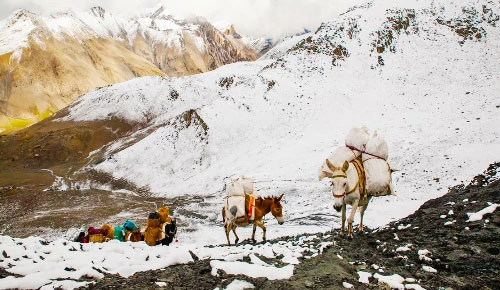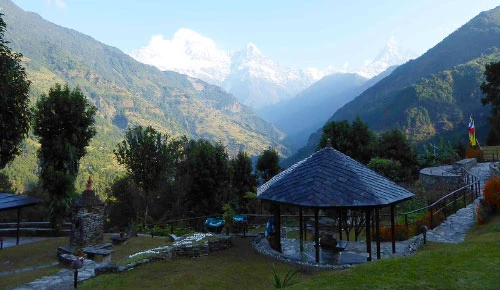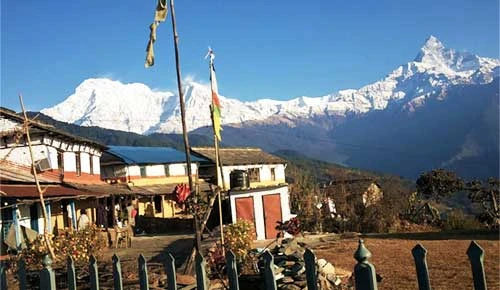Annapurna Sanctuary Travel Guide
Annapurna Sanctuary is a beautiful mountain basin located in the Annapurna region of Nepal. It is a high-altitude trekking destination that is surrounded by towering peaks, including Annapurna South, Hiunchuli, and Gangapurna. The Sanctuary is situated at an altitude of around 4,130 meters above sea level and is surrounded by dense forests, glaciers, and alpine meadows.
History and significance
Annapurna Sanctuary has a rich history and cultural significance, as it is home to several ancient Hindu and Buddhist temples, monasteries, and shrines. The area has long been a spiritual center for local communities and is considered one of the holiest places in Nepal. It is also a popular destination for trekkers and mountaineers, who come to experience the breathtaking beauty of the region and to challenge themselves on the high peaks.
Weather and Climate
The climate in the Annapurna Sanctuary is characterized by its distinct dry and wet seasons, with temperatures ranging from warm during the day to cold at night. The monsoon season usually begins in June and lasts until September, during which time the area receives heavy rainfall and the trekking routes can be difficult to navigate. The best time to visit the Annapurna Sanctuary is between October and May when the skies are clear and the temperatures are moderate. The weather in the Sanctuary is highly unpredictable, and trekkers should be prepared for sudden changes in temperature and weather conditions.
Local culture and customs
Annapurna Sanctuary area, located in central Nepal, is home to several ethnic groups with unique cultures and customs. Some of the local cultures and customs in the area are:
- Gurung Culture: The Gurung people, who occupy the Annapurna region, have a rich culture that revolves around their traditional festivals, songs, dances, and costumes. One of their most important festivals is the Maghe Sankranti, which is celebrated in January.
- Magar Culture: The Magar people in the Annapurna region have a strong connection to their ancestral roots. They have a rich oral tradition, which includes the telling of stories, legends, and songs.
- Tamang Culture: The Tamang people have a rich cultural heritage, which includes traditional dances, music, and festivals. Their most important festival is the Losar, which is celebrated in February and is a time of feasting, drinking, and dancing.
- Thakali Culture: The Thakali people have a strong tradition of hospitality and are known for their delicious cuisine. They celebrate the Dashain festival in October, which is a time of feasting, family gatherings, and the exchange of gifts.
- Religion: The majority of people in the Annapurna Sanctuary area follow Hinduism, but there is also a significant number of Buddhists and a smaller number of Christians. The two religions coexist peacefully in the area.
- Customs: The local people in the Annapurna Sanctuary area have a deep respect for nature and the environment. They believe in the existence of mountain spirits and perform rituals to appease them. Hospitality is also an important part of their culture and visitors are always welcomed with open arms.
Religious and spiritual significance
Annapurna Sanctuary, located in the Nepalese Himalayas, holds great religious and spiritual significance for both Hindu and Buddhist communities. The Hindu community views Annapurna as a symbol of wealth and prosperity, and Annapurna is considered to be an incarnation of the Hindu goddess of food and nourishment, Annapurna Devi. The temple of Annapurna Devi is located in the heart of the Annapurna Sanctuary, and is considered to be a holy site for Hindu pilgrims.
In Buddhism, Annapurna Sanctuary is considered to be a sacred site for meditation and reflection. The peaceful and serene environment of the sanctuary is believed to provide spiritual enlightenment and inner peace to those who visit it. Buddhist practitioners come to the sanctuary to meditate and contemplate the nature of existence, and to gain a deeper understanding of the teachings of the Buddha.
Annapurna Sanctuary is also a popular destination for spiritual seekers, who come to the sanctuary to seek a connection with nature and the divine. The natural beauty and peaceful surroundings of the sanctuary are believed to promote inner reflection and self-discovery and to bring a sense of peace and tranquility to those who visit.
Annapurna Sanctuary holds great religious and spiritual significance for both Hindu and Buddhist communities and is a popular destination for spiritual seekers. The peaceful and serene environment of the sanctuary, combined with its religious and cultural heritage, makes it a place of great spiritual and emotional significance, and a source of inspiration and renewal for those who visit.
Attractions and Activities in Annapurna Sanctuary
- Trekking: Annapurna Sanctuary is one of the most popular trekking destinations in Nepal, with a wide range of trekking routes available, including the classic Annapurna Base Camp trek.
- Scenic views: The region is surrounded by some of the tallest peaks in the world, including Annapurna South, Hiunchuli, Gangapurna, and Machhapuchhre, providing breathtaking views.
- Wildlife viewing: The region is home to a diverse range of wildlife, including the Himalayan black bear, the snow leopard, and the red panda.
- Cultural experiences: The Annapurna Sanctuary trek offers the opportunity to experience the local culture and way of life, as well as visit traditional villages and ancient Hindu temples.
- Hot springs: Natural hot springs, such as Jhinu Danda, provide a great place to relax after a long day of trekking and soothe sore muscles.
- Paragliding: Annapurna Sanctuary offers the opportunity to go paragliding, providing stunning views of the surrounding peaks and valleys.
- Climbing: For more experienced climbers, there are several peaks in the region that can be climbed, including Annapurna South and Gangapurna.
- Photography: With its stunning natural scenery, rich cultural heritage, and diverse wildlife, Annapurna Sanctuary is a photographer's paradise.
- Rafting: The nearby Kali Gandaki River provides opportunities for white-water rafting and kayaking.
- Meditation and yoga: The serene and peaceful surroundings of the Annapurna Sanctuary make it an ideal place for meditation, yoga, and other spiritual practices.
Trekking packages to Annapurna Sanctuary
- Classic Annapurna Sanctuary Trek: This is a classic trek in the Annapurna region that takes you through stunning landscapes and traditional villages. The trek starts from Nayapul and ends in Phedi. The trek is suitable for both beginners and experienced trekkers.
- Annapurna Sanctuary Trek in Luxury: This trek is perfect for those who want to experience the beauty of the Annapurna Sanctuary in comfort. You'll stay in luxurious lodges and be accompanied by experienced guides and porters.
- Annapurna Sanctuary Trek and Culture Tour: This trek takes you through the Annapurna Sanctuary while also exploring the rich cultural heritage of the region. You'll visit traditional villages, meet local people, and learn about their customs and traditions.
- Annapurna Sanctuary Trek and Wildlife Safari: This trek combines a trek to the Annapurna Sanctuary with a wildlife safari in the Chitwan National Park. You'll experience the stunning landscapes of the Annapurna region and encounter a variety of wildlife, including rhinos, tigers, and elephants.
- Annapurna Sanctuary Trek and Rafting Adventure: This trek combines a trek to the Annapurna Sanctuary with a thrilling rafting adventure on the Trisuli River. You'll experience the best of both worlds, enjoying stunning mountain views and white-water rapids.



